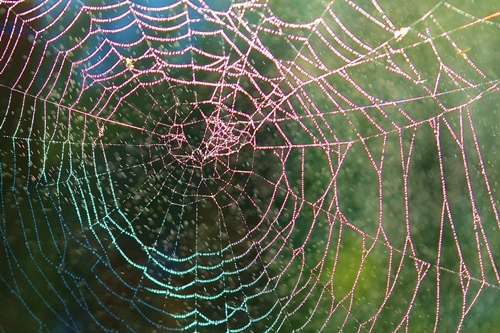28 May 2015. Materials scientists and engineers developed and produced samples of synthetic spider silk, with a process that can adjust the silk’s properties to meet special demands of users. The team from Massachusetts Institute of Technology and Harvard University, led by MIT engineering professor Markus Buehler, published its findings earlier this month in the journal Nature Communications.
Spiders generate their silk from proteins, producing a biomaterial with the elasticity of rubber and strength comparable to steel, resulting in a toughness that exceeds the well-known synthetic materials kevlar and nylon. Spiders use their silk to catch prey, sense vibrations, and protect their young, with spider webs designed for an optimal balance of mechanical functions, longevity, and energy expended by the spider itself.
Buehler and colleagues were as interested in devising a scalable process for designing silk-like materials with properties tuned to meet varying needs of medical and industrial users, as they were in creating new materials. A key part of this process is computer simulation of the chemistry in designing proteins for spinning into different kinds of silk. Simulation makes it possible to screen large numbers of protein candidates to find the exact blend of properties needed to produce the desired levels of strength and elasticity.
Biomedical applications, such as sutures or engineered tissue scaffolds for example, need fibers with extra strength to withstand the wear and tear that human bodies can exert the materials. While natural spider silk is also highly elastic, that kind of flexibility is not always needed when used in medicine. Synthetic silk designed for use in humans, however, needs to retain its “natural” properties, so immune systems do not reject the material and still be absorbed into the body.
Based on the simulations, the MIT/Harvard team genetically modified bacteria to produce the protein building blocks for synthetic silk. The proteins are dissolved in water, then fed through microfluidic channels to force the proteins molecules into a linear structure that produces a fiber stronger than its components.
The researchers produce fiber samples at room temperature by spinning the silk into patterns comparable to natural, and familiar, orb spider webs. The team uses a 3-D printing process called direct ink writing that results in cylindrical threads with uniform diameters.
While load tests show the engineered materials did not have the strength of natural spider silk, the researchers believe they can adjust the silk’s properties to add strength. The design process, say the authors, would also enable adding characteristics to the material rarely associated with spider silk, such as heat or electrical conductivity that could expand its applications into aerospace and other industrial uses.
Read more:
- Purdue Spin-Off Designing Customized Synthetic Tissue
- Biomedical Applications for Nanofibers Sought in Challenge
- Synthetic Polymer Shown to Reduce Heavy Bleeding
- Patent Issued for Engineered Peptides Forming Hydrogels
- Epoxy/Carbon Ink 3-D Printed into Lightweight Cell Material
* * *


 RSS - Posts
RSS - Posts
You must be logged in to post a comment.